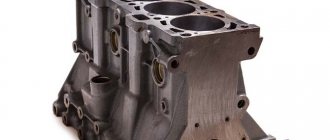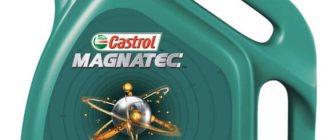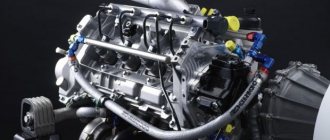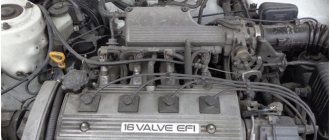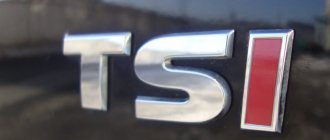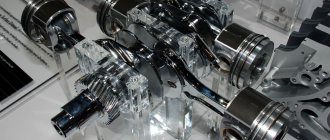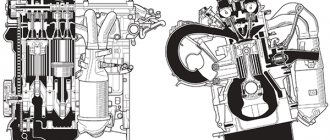What is a millionaire engine
Before looking at which cars are equipped with a million-dollar engine, it’s worth considering what they are. Such power plants are capable of serving more than a million kilometers, which is why the corresponding name arose. To achieve such performance, the motor must have a number of characteristics, such as maintainability and durability.
At the same time, millionaires do not necessarily have to operate without a single repair during this entire service life. This is due to the fact that the manufacturer does not provide a service life of 1 million kilometers for all parts. The most reliable Japanese engines that allow achieving such indicators are produced by Toyota. But not every unit is capable of producing such a resource. It is also important to take into account timely maintenance of the car, as well as the driver’s driving style.
Engines are designed for long-term operation
Whose engine is better?
There is always a lot of controversy in this matter, since one says that nothing can be more reliable than Toyota engines, another can only serve Nissan, and the third is quite happy with Minsubishi...
As you understand, usually everyone praises the cars of the brand they drive and at the same time curses the car of their neighbor from another manufacturer, which they have never used. I would like to immediately note that many attachments on Japanese engines are produced by third companies and, for example, the LD20T-II engine (Nissan) is equipped with a Hitachi generator, which can just as easily be installed on a 2C-T (Toyota) and, accordingly, the probability of failure generator failure on both engines is the same.
Basically, everything said below will concern the mechanical part of the engines, and not their attachments.
Engine choice: gasoline or diesel
A controversial topic among drivers is which engine is the most reliable: gasoline or diesel. There are only 3 types of power plants capable of achieving a millionth resource. These include:
- Diesel, most of which are considered very reliable and durable.
- Gasoline, made in the form of an inline 4. Their service life is comparable to diesel models.
- Gasoline inline 6s. Despite the high power levels they develop, such models have virtually no vibrations while driving.
Occasionally, domestic GAZ cars were able to overcome the mileage threshold of a million kilometers. This situation occurred with type 406 motors. But the most reliable are diesel engines, which is due to their design.
Toyota JZ
A rare rating of “immortals” does not include the legendary line of in-line six-cylinder Toyota JZ engines - these are generally one of the most reliable and renowned Japanese engines, which are famous all over the world. Units with a volume of 2.5 liters in naturally aspirated versions and with a supercharging system (1JZ-GE/1JZ-GTE), as well as 3.0-liter 2JZ-GE/2JZ-GTE with power up to 320 hp. known not only for their survivability, but also for their ability to withstand quite extreme tuning on standard internal engine parts. In the second half of the nineties, the 1JZ-GTE replaced two turbochargers with one and received a variable valve timing system, which made it possible to develop maximum torque over a wider rpm range. By the way, around the same time, VVT-i appeared on the 2JZ.
List of cars with the best engines
It’s also worth considering which cars have million-dollar engines. It is important to say separately about each model.
Mitsubishi 4G63
This engine was first installed on cars in 1982. At the same time, at first only 1 camshaft was installed on the model. However, after 6 years they began to be equipped with two such elements at once. These power plants were used not only by Mitsubishi, but also by the Korean companies Hyundai and Kia. During the entire production period, many modernizations were carried out.
Toyota 3S-FE
Another Japanese representative of the “millionaire” is the Toyota 3S-FE engine, which has a volume of 2 liters. It is considered one of the most reliable inline 4-wheel drive models. It was produced for 14 years from 1986.
A feature was considered to be increased maintainability, as well as the ability to work at high loads for a long time. With timely maintenance, such engines ran for more than 1 million km, and sometimes the mileage reached 1.5 million .
Toyota engines are considered one of the most reliable
Honda D-series
This type of power plant was produced in more than 10 different versions. Its volume varied between 1.2-1.7 liters depending on the modification. The maximum engine power was 130 hp. pp., which was always enough for the car models with which it was equipped. D15 and D16, based on multiple tests, turned out to be the most viable options.
Toyota 1JZ-GE
This type of motor is available in 2 types: 2.5 and 3.0 liters. A similar inline 6 was produced for 18 years from 1990. The reliability of such power plants is evidenced by the fact that some models have served more than 1 million km even without major repairs. These engines were used both in Toyota cars and in the premium Lexus brand, whose cars were produced for the US market.
BMW M30/50
One of the most reliable engines of the Bavarian automaker is the M30 model. It was produced in several versions. The first had a volume of 2.5 liters, producing 150 liters. s., and the second is 3.4 liters with a power of 220 hp. With. But another engine model, the M50, had several modifications with a volume range of 2-2.5 liters, as well as power ratings of 150-195 “horses”. The reliability of this power unit was ensured by the presence of a cast iron body and the use of a chain rather than a belt as a timing drive.
Mercedes-Benz OM602
A well-known German diesel engine that was produced for 17 years from 1985. Despite the small power figures, which did not exceed 130 hp. pp., even in maximum versions the engine was distinguished by increased reliability. Often there were cars without major repairs of the power plant that traveled more than 1 million km. This ensured the worldwide fame of this company as a manufacturer of reliable and high-quality cars.
There are engine lines with a service life of more than 1 million km. Due to this, such units are called “millionaires”. The main manufacturers of such power plants are BMW, Toyota, and Mercedes. However, it is important to monitor the car and carry out timely maintenance so that the engine lasts a long time.
Indestructible motor for the 2AR-FE crossover
The last engine we will talk about today is another representative of the Toyota segment, which in its operation can give a head start to anyone. This is the 2AR-FE line, which was installed on the Toyota RAV4 and Alphard. We know it best from the RAV 4 crossover with its incredible operating capabilities. The engine is made of high quality and can offer its owners simply amazing operating advantages:
- with a volume of 2.5 liters, this gasoline unit is enough for 179 horsepower and an incredible 233 Nm of torque, the characteristics are suitable for a crossover;
- cars with such settings are completely unpretentious when it comes to gasoline, there is no need to look for the best fuel, you can even fill with 92 gasoline without a twinge of conscience;
- a chain on the timing system eliminates problems with valves; its replacement is necessary once every 200,000 kilometers, but the engine life goes far beyond 1,000,000 kilometers;
- there are great benefits to operating vehicles in terms of fuel consumption, maintenance costs - there are practically no requirements for service, but its frequency should be normal;
- Undoubtedly, the most striking example of the use of the unit is the Toyota Camry, in which this engine played a special role during the long period of production of the car.
As you can see, this power unit has also earned the attention of the world community. All motorists who have encountered the capabilities of the power plant talk about its incredible reliability and simply excellent operating options. In the worst case, this engine will have to be sent for major repairs at 500-600 thousand kilometers. All that remains is to periodically go for service and enjoy the reliability of this unit. We invite you to watch a video about the top five engines from the corporation:
List of cars with a million-dollar engine. Read and envy
In the opinion of most car enthusiasts, a list of cars with a million-dollar engine is decisive evidence in the dispute about whose cars can be considered the most reliable.
Legendary models are put forward as indisputable arguments in the battles between supporters of European and Japanese cars. Fans of the “Americans” often get involved in the dispute. Even if none of the debaters have ever seen such a car, the main thing is to know that it exists. Or at least once existed. The dreams and legends of a car that never breaks down and can run further than you can imagine will never die. However, these dreams cannot be called completely groundless: mythical cars, whose engines have an estimated mileage of 1 million km, were actually produced. We have not found a single reliable evidence that any of them actually covered the planned distance, but beyond 600-700 thousand km you can be absolutely sure.
The list of cars with a million-dollar engine is actually not that small. There was a time period when the desire to equip cars with an indestructible engine spread almost throughout the world. Some companies stuck with this idea until the new millennium.
Millionaire engine - a list of cars with the best engine
see. Carburetor engines are equipped with an automatic choke setting system; carburetors have an idle speed solenoid valve. The engine is started after pressing the gas pedal all the way. The throttle spring is weakened, after which the air damper closes to the required angle. As the engine warms up, the temperature of the bimetallic spiral increases, which, when heated, contracts and closes the damper. In engines with fuel injection, there is no need to press the gas pedal before starting - gasoline is supplied automatically (the control unit is responsible for this function).
Nissan diesel engines differ from gasoline engines in their greater unpretentiousness, the ability to express themselves “to the fullest” outside the city, on rough terrain. Most of these engines are equipped with a single-piston high-pressure fuel pump. The purpose of the plunger is to create the necessary pressure on the cylinder injectors, according to their location. Diesel car engines are equipped with glow plugs to start the engine. On Nissan cars, depending on the engine modification, more than four types of spark plugs can be installed, differentiated by shape, thread, and applied voltage. Glow plugs on Nissan cars play the role of a sprayer, located in front of the injector jet (the spray needles themselves do not have sprayers). A fuel flash in a diesel engine occurs as a result of air compression in the cylinders. The temperature increases when voltage is applied to the glow plug - in this way it is possible to start a cold engine better (many Nissan models are equipped with a heating system for the incoming air, which allows you to start the car in cold periods without any problems). After the diesel engine starts, the voltage from the spark plugs is not completely removed - the charge is reduced according to a special scheme until the engine warms up completely.
A remarkable feature of Nissan engines is their precision assembly and attention to detail. Some owners of Nissan cars complain about its performance after 2-3 years of using the vehicle. As it turns out later, drivers “forget” to use motor oil and change the fluid irregularly. At the same time, it is engine oil (both mineral and synthetic formulations are available in the retail chain) that reliably protects the “heart” of the vehicle and significantly increases its service life. It is clear that during operation of a Nissan engine, significant forces are created inside it. Unlubricated pistons fail much faster, crack and fall apart, unable to withstand excessive loads. It is especially important to use special oil in winter - during cold starts the engine is most vulnerable. According to service center employees, more than half of all engine failures in Japanese Nissan cars are due precisely to the fact that their owners did not pay due attention to lubricants. The oil was either rarely changed, or low-quality products were purchased, as a result of which engine protection was not absolute.
Nissan gasoline and diesel engines will serve their owners for a long time and will not cause any particular problems during operation if car enthusiasts begin to understand the importance of using high-quality motor oil.
Related articles:
- Toyota Verossa The company presented the Verossa model as an “emotional sedan”, luxurious on the outside and stylish on the inside: an extraordinary design...
- Land rover Exclusive and prestigious representatives of the legendary Land Rover family are ideal for a successful and modern person…
- Mercedes from class 2001 To buy a car Mercedes-Benz C-class IV (W205) 180 2021 38,700 km which is located…
- Manufacturer Subaru Each of us has heard about Subaru cars, because this brand is popular and in demand...
BMW family
If we compare the number of models capable of running the maximum distance without major repairs, then the Bavarians can be considered the winners. At different times, they gave the world several models designed for millions of kilometers.
BMW M30 engine
the automaker equipped its cars with models 5-7 from 1968 to 1994. Engine volumes were different, from 2.5 to 3.4 liters, producing 150-220 horses. Reliability was ensured by a simple design, and half a million BMWs of those years ran without difficulty. And they often did not reach the ordered result, not because of the engines, but because of difficulties with rear-wheel drive.
Next version – BMW M50
- somewhat inferior in power to the previous one (maximum 192 hp with a volume of 2.5 liters) and lived a slightly shorter life: from 1992 to 1997, but in terms of reliability it still proudly held the banner, and the mileage was 500- 600 thousand km for these engines was considered something ordinary.
BMW M57
: a 6-cylinder inline engine with a power of 201-268 hp, installed on almost all models born in 1998-2008, from 3 to 7 series. It was also supplied to the off-road legend – Range Rover.
BMW M60
(this is already a V8) was installed on 5 and 7 in 1992-1998. An innovation in it was the installation of nikasil cylinders, which had extremely high hardness and were considered virtually non-wearable. True, fragility and intolerance to sulfur inclusions in the fuel were added to the characteristics, so the version was discontinued and Nikasil was replaced by Alusil.
The most successful option for the Germans was, perhaps, the M57. But even with him, the cars have long since left the race.
BMW / BMW
The German car manufacturer confidently leads this list. Bavarian engines have been operating for many years without caps. renovations to this day. Different engine models were produced, at different times and in different modifications, so there were some that could easily cover a million kilometers. So, one of these engines is the power unit with the number M30
. It was installed in the fifth and seventh models from the early 70s to the 90s. The engine had 2.5 liters and 3.4 liters, and the power was 150 and 220 horses.
How was such incredible reliability achieved? The answer is due to its simplicity. The engine is actually very simple in design. It turns out that the simpler the engine design, the further it can go. It is for such an engine that 500 thousand mileage is a piece of cake.
The Germans also had another development - M50
. The engine was a little weaker than the previous one, but was capable of driving more than 600 thousand. It was produced from 1992 to 1997.
The next model is M57
. The engine had six cylinders and its power ranged from 201 to 268 horsepower. It was installed in models 3-7 series from the late 90s until 2008. It is noteworthy that such an engine had the honor of being under the hood of the legendary Range Rover.
M60 V-engine
with eight cylinders was installed on the seventh and fifth generations of BMW from 1992 to 1998. They used unique cylinders (I just don’t remember what metal, Nikasil in my opinion), which had a very low wear rate. The main disadvantage of the engine is its sensitivity to impurities in the fuel. Then the engine was discontinued.
The M57 engine turned out to be a little more successful in this regard, but over time it was also removed from the assembly line.
Japanese offers
Millionaires were issued by different companies and at different times. Some concerns started even earlier than the Bavarians - and also stopped producing cars with such engines earlier.
Toyota turned out to be the most prolific. The Toyota 3S-FE series engine was installed in 1986-2000. on Camry (the last one came out in 1991), Celica T200, Carina (this one survived right up to 1998), Corona T170 / T190, Avensis (long-lived: with such an engine it was produced back in 2000), RAV4 (can also be found in 2000) , Picnic (there is even a 2002 model with the above engine).
The engine was especially good at its high tolerance to poor maintenance with high loads and good maintainability. Toyota 1JZ-GE and 2JZ-GE engines are truly a legend. Years of life – 1990-2007; They were equipped, in particular, with Mark II, Crown, Soarer, Chaser, Supra and the Americans Lexus Is 300, GS300. A million kilometers on them is a recorded fact.
The Mitsubishi 4G63 million-dollar engines appeared in 1982, and varieties are still found today, not only in native models, but also in Kia and Hyundai products, although whether they can be called million-dollar engines is a question. Only naturally aspirated versions are considered capable of covering 1 million km. The latest model released is Mitsubishi Lancer Evolution IX 2006.
The next “Japanese” with a large resource is the Honda D-series. The engine had a long line of varieties: volumes varied between 1.2 and 1.7 liters. The engines were produced in 1984-2005. They were supplied with HR-V, Civic, Stream, Acura Integra, Accord.
Related articles:
- “How to decipher a Japanese car auction sheet”;
- “How to determine the year of manufacture of a Japanese car.”
To be honest, the list of cars with a million-dollar engine is interesting rather hypothetically. Calculations at the level of school arithmetic show that with an average annual mileage of 25 thousand km, the engine resource will be exhausted in 40 years. During this time, all the filling will fall out in the car, even if the engine honestly continues to pull. In addition, the same statistics show that in Europe and Japan people prefer not to keep a car for more than 5 years, and this period is decreasing every year. Probably, all this together led to the cessation of production of cars with such a resourceful engine.
Japanese engines
As I already said, million-dollar engines were produced by many companies at different times. Then there were even entire concerns that sought to create a “perpetual motion machine” before BMW began to do so. But they no longer exist.
One of the most successful concerns that has survived to this day was Toyota. Their cars were equipped with 3S-FE engines and were produced from about the 80s to the 2000s. This engine could be seen on such popular cars as: Camry, Celica T200, Carina, Avensis and Corona. But other little-known car models also had such an engine. The main feature of the 3S-FE engine is its unpretentiousness and endurance.
There were also the 1JZ-GE and 2JZ-GE engines, which were produced from the 90s until 2007. These engines were installed on the Chaser, Supra, Crown and, oddly enough, Lexus. What is interesting is the recorded official mileage of 1,000,000 kilometers.
Mitsubishi also sought to create a million-dollar engine. The company released its first engine in 1982. Its modifications are still installed today on some Kia and Hyundai cars.
The last “Japanese” I will name today is Honda. The D-series model stands out most of all, but the volumes of such engines were different - from 1.2 liters to 1.7. Engines were produced from 1984 to 2005. They can be found on Accord, Civic and HR-V.
What do you want to say in the end? Of course, a mileage of 1,000,000 kilometers is a purely conditional mileage. They are not factual, but only speak about the reliability of the units. After all, to travel one million kilometers, you need to travel at least 25 thousand a year, and then, in 40 years, you can reach a million. What kind of car can withstand 40 years of use? And if you consider that today people change their cars approximately once every 5 years, then the question of a million mileage is pure theory.
That's all for me. Thank you for your attention! Thumbs up and subscribe to the channel - there is a lot of interesting things ahead!
Source
What is a millionaire engine?
The first step is to find out what lies behind this phrase “millionaire engine”. This can be deciphered as a power unit that has covered a distance of more than 1 million km.
Many will immediately begin to object that this is all a myth and this cannot happen, but in fact such motors exist, and there are many of them.
The impeccable reliability of the internal combustion engine is determined by the following main indicators:
- Maintainability.
- Durability.
- Reliability.
But it is worth saying that the concept of million-dollar engines does not mean at all that the car will cover such a mileage without major repairs. This means that the manufacturer provides a parts lifespan of one million. The undoubted leaders in the production of such motors are:
- Japanese cars;
- American-made cars;
- German cars.
It is also worth saying that not all engines will be able to go through such a mileage, because the condition will largely depend on timely maintenance (MOT) and driving style.
Toyota million-dollar engines - legendary engines from Japan
Toyota is always one of the most attractive cars in the world. This is a brand that is truly worthy of respect and can offer you unique equipment options. At each stage of development, the manufacturer had his own considerations regarding a high-quality engine and normal technical support for the machine. There were periods in the history of the automotive industry when many manufacturers in the world strove specifically for the developments of the Japanese company. Today we will talk about Toyota engine models that have gained fame over millionaires. Note that among modern units there are very few such representatives. The company began to produce so-called disposable engines that are not subject to major repairs. This is a generally accepted fact in the automotive world, as all manufacturers follow this path.
It is very difficult to consider the best Toyota engines, since the company really offers a lot of interesting power plant options. Over decades of successful work, the Japanese have developed and successfully launched into production more than a hundred models of units for their equipment. And most of the developments were successful. The company began to fill the main set of engines with enormous advantages in 1988 and later until the very beginning of the new century. This is the era that brought glory to the manufacturer and made it world famous. The range of power units is so large that choosing a few of the best among this army of equipment will not be easy. However, today we will try to consider only the most famous and successful installations that the corporation has released in its life.
Content
Which engine is better, gasoline or diesel?
Also, among motorists there is still ongoing debate about which type of engine is more reliable and how long does it last, gasoline or diesel? To answer this question, it is necessary to resort to statistics, which show that cars with a diesel engine are no longer killed. Motors that have actually covered such a resource can be divided into several types:
- diesel These types of motors have gained a reputation for being durable and reliable;
- gasoline inline fours. Cars with such engines compete for popularity and reliability with diesel ones;
- gasoline inline sixes. These motors are highly powerful and have virtually no vibration while driving;
- V-shaped "eights". Such engines come in large sizes, and unlike the first three, they cannot boast of a long service life of the vehicle, although this cannot be said about engines made in the USA.
There have also been rare cases when a domestic GAZelle car with a 406 engine exceeded the 1 million km mark. We have figured out what a millionaire is, now we should move on to a small list of such cars, because many motorists do not know on which cars such units can be found.
Millionaire engines. Engines capable of driving 1,000,000 km. Characteristics
Memories that the technology of past years of production was more reliable than modern products are now more justified than ever. So, which engine can be considered reliable and which cars were equipped with engines that were often awarded the honorary title of “millionaire”?
Unreliable engines have always existed, but in the past, car owners en masse did not understand the reasons for the formation of scuffing on the cylinder walls; the sight of miniature pistons and ultra-thin rings did not amaze them, and problems with the timing chain usually arose only at very high mileage. But over the years, environmental standards have become stricter, and manufacturers have been forced to adjust technology to ensure that motors meet the standards. If we summarize in a concise form the main problems of modern units, due to which the number of failures at low mileage has noticeably increased, then this is, on the one hand, a complication, and on the other, a lighter design, a reduction in parts (for example, crankshaft journals, pistons and timing chain links) in size, increasing operating temperature and introducing turbochargers.
Previously, engines for the most part did not have such a sophisticated design, that is, they were not burdened with technical solutions that increased overall unreliability and made the probability of failure at runs of just over 100 thousand kilometers (and sometimes noticeably earlier) high or very high. For example, the developments of past decades were not distinguished by complex fuel equipment, and the durable chain drive lasted over 250 thousand kilometers. At the same time, the service life of “old” engines, of course, subject to more or less adequate maintenance, often exceeded 500 thousand kilometers. It should be noted that the term “millionaire” in a certain sense is an exaggeration, which only indicates a very high margin of safety. In fact, running a million kilometers without major repairs is a very difficult task. And, nevertheless, the units of past years clearly demonstrate the validity of the statement “the simpler, the more reliable.”
List of cars with million-dollar engines
Now it’s worth presenting a small list of engines that have actually exceeded their intended service life, i.e. are millionaires. Among the gasoline ones, the following can be noted:
- Mitsubishi 4G63;
- Toyota 3S-FE;
- Honda D-series;
- Toyota 1JZ-GE and 1JZ-GE;
- BMW M30 and M50.
The following engine brands are among the long-lived diesel engines:
Well, now each model needs to be considered in more detail.
Mitsubishi 4G63
The Japanese 2-liter engine was born in 1982. The first models were produced with one camshaft, but after 5-6 years, cars with two camshafts began to be produced. Such engines were installed on Mitsubishi, Huyndai and Kia. Over the long years of production, they have been modernized several times.
It is worth noting that its licensed copy is still produced in factories in China, and is currently installed on a Chinese-made Brilliance car.
Toyota 3S-FE
The 2-liter Toyota 3S-FE engines are also considered millionaires. Among the inline fours, it is one of the most reliable and indestructible. Its production period is from 1986 to 2000. The 16 valve four-cylinder engine is highly maintainable and can withstand high loads. If scheduled maintenance is carried out in a timely manner, such engines can travel over 500 thousand kilometers without major repairs.
Honda D-series
The model range of the car manufacturer Honda, in its assortment, has more than a dozen different engine modifications, with volumes from 1.2 to 1.7 liters, and are rightfully considered indestructible. In such engines, the internal combustion engine power reaches 130 horsepower, which is quite good for cars with small volumes. As numerous tests have shown, the D15 and D16 models are considered the most unkillable.
Toyota 1JZ-GE and 1JZ-GE
Such engines already belong to in-line sixes, and they were produced between 1990 and 2007. They are presented in two volumes: 2.5 and 3.0 liters. There have been cases where some cars with such engines have covered a million kilometers without major repairs. Some motorists call them “legendary”. They were installed both on their own cars and on some American Lexus models.
BMW M30 and M50
Cars equipped with engines of such models should also be classified as million-dollar vehicles. The M30 model was produced with volumes of 2.5-3.4 liters, and had a power from 150 to 220 “horses”. But the M50 model was produced with volumes of 2. -2.5 liters and engine power from 150 to 195 horsepower.
The main secret of the reliability of these engines was the cast-iron housing of the power unit, and the timing drive was carried out by a chain. Such engines are capable of covering 500 thousand kilometers without the need for major repairs, and the service life provided by the manufacturer is a million kilometers.
BMW M57
Cars with these types of engines are also among the million-dollar cars. They were produced between 1998 and 2008, and were installed on almost all BMW cars that were produced during this period. In addition to high reliability, the main positive feature of such engines was the impressive dynamics of the car.
Mercedes-Benz OM602
This diesel engine was produced from 1985 to 2002, and had power from 90 to 130 horsepower. As you can see, this model is not very powerful, but its main distinguishing ability is high reliability. If you follow all the instructions in the service book on time, then such engines can travel up to a million kilometers without serious breakdowns.
1.9 TDI engine is the best
This is one of the best diesel engines of the last 20 years! Many people rate it an A. The 1.9 TDI diesel engine appeared on the market in 1991 and existed until 2010. During that time, it underwent several modifications (replacement of the separation pump with a pressure pump, different power options - from 75 to 160 horsepower).
It was not characterized by quiet operation, but one could count on low fuel consumption, very cheap repairs, and more than sufficient strength (especially for the old and proven versions with a distribution pump - 90 and 110 horsepower).
At present, we should expect problems typical of modern turbodiesels, which arise due to high mileage. The most common ones that fail are:
- exhaust recirculation valve;
- air flow meter;
- high pressure fuel pump;
- injectors require cleaning;
- Cracks appear in the vacuum hose connection.
In more powerful versions, defects occur in the variable geometry turbine (VTG), dual-mass wheel, injectors and generator pulley clutch. The only disappointing nuance in the history of the 1.9 TDI engine, the version codenamed BXE from 2006-08, is the frequent failure of bearings (material defect), which occurs after covering about 150 thousand kilometers.
Top 10 most reliable million-plus engines
Many car lovers probably have a question: which engine is the best, most reliable and practical. German, Japanese or maybe American? Some 30 years ago it was believed that the larger the engine capacity, the better it was. But over time, this trend changed and today the engine size does not mean anything. The modern trend in the automotive industry is to reduce engine size while maintaining power. This became possible thanks to the use of turbines. Thus, it is possible to achieve a reduction in fuel consumption even with an increase in engine power, which is very important in the modern world, especially with constantly rising fuel prices. In addition, the motor must have a good service life and maintainability.
Surely many have heard stories from auto repairmen about indestructible engines that were opened with millions of miles, and they were inside as good as new.
Today we’ll look at the most reliable and practical motors, which have proven themselves to be the best over time. It is worth adding that this list is far from complete and includes the most famous mass-produced engines.
Content
Diesel engine 1.6 TDI
This young engine (offered since 2009, the most popular versions with a capacity of 90 and 105 horsepower, starting in 2014 - 110 and 120 horsepower) is increasingly appearing on the secondary market. So far, its only serious problem has been cases of injector damage , which usually reflects poor fuel quality. Therefore, it is necessary to refuel with diesel fuel only at proven stations and replace the fuel filter not every 60 thousand kilometers (in accordance with VW recommendations), but only every 30 thousand kilometers.
Other problems occur rarely and include breakdowns of the turbine, control electronics, and oil leakage from the engine (may be due to damage to the head gasket). As a rule, the 1.6 TDI engine is called economical and pleasant during everyday use of the car, especially if it is under the hood of a class B or C car. Average fuel consumption is satisfactory - about 5 liters per 100 kilometers.
Today, the Nissan Corporation is one of the most successful Japanese projects. The car brand has received wide appreciation all over the world - owners fell in love with these vehicles for their practicality, reliability, unpretentiousness, and ease of operation. Today the company produces cars both for the city and for cross-country driving, and produces a wide range of public transport vehicles. How did it all start? What was the impetus for the founding of an automobile corporation that is firmly among the world leaders in the production of reliable and practical vehicles?
The date of creation of the company is considered to be December 26, 1933 - it was on this day that Nissan Motor Co., Ltd. was founded. Yoshisuke Aikawa was elected the first president of the company. In 1934, the construction of the Nissan Yokohama Plant automobile plant was completed, and Nissan's victorious march around the world began.
The first vehicles were exported to America and Asia. The management's plan was to produce 10,000-15,000 types of cars per year, which was soon put into practice. A significant step that allowed the company to get ahead was the large-scale introduction of presses for the production of body parts - the manual finishing of metal sheets was done away with.
We recognize Nissan cars primarily by their original logo. It first appeared in 1935. The basis was a red circle (symbolizing the rising sun), and the blue color of the company name meant the sky. Without a doubt, the corporation's path to the heights of fame and recognition was difficult and thorny. There were many obstacles along the way that had to be overcome; not everything worked out the first time. One of the first facts of recognition was the presentation of the 10th “Prize of the Year” to the company’s management in 1960 for the highest achievements in the field of industrial engineering.
Much of the credit for the global recognition of the car manufacturing company goes to its engines. During the entire existence of the automobile enterprise, the following types of engines were installed on vehicles: gasoline carburetor, gasoline with injection and diesel.
In terms of basic parameters, Nissan gasoline engines are largely similar to similar models from European and American manufacturers. In order for them to start, the fuel-air mixture ratio must be at least 1:13, the compression ratio must be at least 6 kg/sq.m.
The most reliable diesel engines
Over the past few decades, automakers have managed to create quite a few masterpieces of engine engineering. Diesel power plants are traditionally considered the most reliable. Diesels are used by those who need to travel a lot. Older generations of engines have a relatively simple design with a good margin of safety.
Mercedes-Benz OM602
These engines include the OM602 family of 5-cylinder engines with two valves per cylinder and a Bosch mechanical high-pressure fuel pump. These engines deservedly hold the palm in terms of mileage and reliability. Cars with such diesel engines were produced from 1985 to 2002. These engines were not famous for their high power; they had from 90 to 130 horsepower. But on the other hand, this design promised advantages in reliability and efficiency. You can find such engines on Mercedes in the legendary 124 body, as well as on the W201, on G-class SUVs, on T1 and Sprinter vans. Even on later W210s, many examples have mileages exceeding half a million km. Record runs occur over 2 million km. And if you take care of the fuel equipment and attachments in a timely manner, the engine design will almost never fail.
BMW M57
Bavarian engines are also in no way inferior to their main competitor. A well-deserved example of this is the BMW M57. In addition to its impressive reliability, this inline six-cylinder diesel engine is also distinguished by its very lively character. The BMW 330d in the E46 body contributed to the change in the image of the sports diesel engine. It could no longer be considered a slow car for pensioners or taxi drivers. This is a dynamic car with a powerful and high-torque diesel engine. This turbodiesel engine won the engine of the year award in category A (volume from 2.5 to 3 liters) from 1999 to 2002. And its modifications won this award in 2005, 2006 and 2009. The power of these engines in different versions varied from 201 to 286 horsepower. They were produced from 1998 to 2008 and were installed on most Bavarian models of the decade from 3 to 7 series. Also, options with the M57 engine are found on Range Rovers.
By the way, the m57 motor had an equally legendary ancestor - the m51 motor family. They were produced from 1991 to 2000. They encountered minor problems, but serious breakdowns are extremely rare and most often they arise through the fault of the car owner himself. So, these engines run very well and runs of half a million and 1 million kilometers without repair are commonplace for them.
Diesel units
The list of cars with million-dollar engines traditionally begins with diesel engines. These motors, even in older generations with a simple design, had an excellent resource reserve:
Mercedes-Benz
A Mercedes with an OM602 diesel unit has 5 cylinders, 2 pistons each, and a mechanical fuel injection pump. It is among the first in terms of mileage and remaining running of cars with such a unit. Motors were produced for twenty years until 2002 inclusive. Power reaches only 130 hp, but efficiency and reliability compensate for the shortcomings. The successors are model OM612 and model OM647.
What machines have these devices? You can meet them in Mercedes with the W124, W201 and W210 bodies. They are used in G-Class SUVs, T1 RVs and Sprinters. Record engine mileages cross the line of 2,000,000 kilometers, and half a “lemon” of kilometers is considered the minimum.
BMW M57
BMWs with an in-line engine are not inferior to Mercedes, although they have 6 cylinders.
Moreover, they have a power of 200-286 horses, they were produced for ten years until 2008, and were installed in most models.
What cars are these record holders on? These diesel engines are found in Range Rover cars. Despite minor breakdowns, mechanics recognize its endurance until major repairs. The minimum mileage to the capital of such an engine is 300-500 thousand mileage.
The most reliable gasoline engines
Now let's move on to gasoline engines. In the domestic market they are loved more than diesel ones. Still, gasoline does not freeze in winter, and the design of gasoline engines is simpler than diesel engines.
Toyota 3S-FE
The honor of opening the list of the most reliable engines falls to the legendary Toyota 3S-FE engine. This representative is considered one of the most reliable and unpretentious units. It is thanks to this engine that legends and stories about the unkillable Japanese of the nineties circulate among car enthusiasts. A four-cylinder, two-liter engine with 16 valves is typical for mass-produced engines of the nineties. This also includes the camshaft drive by a belt and simple distributed injection. This engine was produced from 1986 to 2000. Power ranged from 128 to 140 horsepower. More powerful versions of this engine, 3S-R and turbocharged 3S-GTE, inherited a successful design and good engine life. These engines were installed on a number of Toyota models. They can be found under the hood of the Celica t200 Toyota Carina from 87 to 98, on the Toyota Corona and Avensis, 2000 RAV4. Mechanics note the engine’s amazing ability to withstand high loads, the ease of its repair and the overall thoughtfulness of the design. With good maintenance, such engines ran 500,000 km without major overhauls.
Mitsubishi 4G63
Next we have another unit that knows how not to bother owners with minor problems - this is the legendary Japanese Mitsubishi 4G63 engine. This two-liter gasoline engine and its variants appeared in 1982. And licensed copies and successors are still being produced (!). Initially, the engine was produced with one camshaft and three valves per cylinder, but in 1987 a version with two camshafts appeared. The latest versions of the unit were installed on version 9 of the 2006 Mitsubishi Lancer Evolution. Such engines have found a place under the hood not only in Mitsubishi cars, but also in Hyundai and Kia. Over all these years of production, the engine has been modernized several times and all of its latest versions have a timing adjustment system and more complex power supply and inflation systems. However, all this does not have the best effect on its reliability. But the maintainability and convenience of the layout remained at the same level. Only naturally aspirated versions of the engine are considered millionaires, although turbocharged ones can also have a very long resource by the standards of competitors.
Honda D15, D16
Next on our list are Honda engines of the D series. This is another Japanese family of engines, which includes more than a dozen varieties with a volume of 1.2 to 1.7 liters and has rightfully earned the status of being practically indestructible. They were produced from 1984 to 2005. Options D15 and D16 are considered the most reliable. They developed 131 hp. at operating speeds up to 7000. Such engines were installed on Honda Civic, HR-V, Stream, Accord and Acura Integra. With a combat nature and a small working volume, the service life before major repairs is up to 500,000 km. These engines produce a wonderful acoustic sound - the epitome of progressive engineering. Also, the thoughtfulness of the design gives this engine a chance for a second life and many more hundreds of thousands of kilometers.
OPEL X20SE
In fourth place among gasoline engines is a representative of the European school of engine building, namely the X20SE from the Opel engine family. This motor became famous for the fact that it often outlived the cars on which it was installed. A simple design: 8 valves, a camshaft belt and a simple distributor injection system are the secrets to longevity. Like the most successful examples of the Japanese school, it has a volume of 2 liters and the power of different options ranges from 114 to 130 horsepower. These engines were produced from 1987 to 1999 and were installed on models such as Kadett, Astra, Vectra and Omega, as well as on the Australian Holden and American Buick 5. These engines can easily not only cover half a million mileage without major overhauls, but if treated with care, reach up to 1,000,000 km. The sixteen-valve varieties X20XEV and C20XE no longer have such health, but they can also please their owner for a long time.
BMW M60
Now let's move on to V-shaped eights. V8 engines for passenger cars have a lightweight design and, given the complexity of the layout of such a large engine, this does not add reliability to the unit. V-shaped engines, which owners suffer from major and minor breakdowns, can easily cross the threshold of half a million kilometers, which can be counted on one’s fingers. And one of them is again the Bavarian product BMW M60. Over the years, the company has modernized its V8; the cylinders had a special coating, which gave a good margin of safety. A relatively small degree of boost and good design development made it possible to create a truly resourceful motor. The use of nickel-silicon coating makes the cylinders of such an engine virtually wear-free. Up to half a million kilometers, often even the piston rings in the engine do not need to be changed. But there is one drawback - the durable coating of the cylinders is afraid of sulfur in the fuel, and after refueling with low-quality fuel, serious problems began. Later, the use of nickel plating was abandoned in favor of the use of an aluminum alloy, which had less durable characteristics, but was more resistant to low-quality fuel. Such engines were installed on the BMW 5 and 7 Series from 1992 to 1998. Their simplicity of design, high power and good margin of safety allow them to travel more than half a million km. The main thing is not to refuel with high-sulfur Canadian gasoline.
Toyota JZ
Let's move on to in-line sixes - these engines are rightfully considered one of the most successful. The reliability of in-line 6-cylinder engines with million-dollar engines was based on a relatively simple design and balance, and therefore the absence of vibrations. At the same time, such motors produced good power. And now we will talk about Toyota engines 1JZ GE and 2JZ GE. These 2.5 to 3 liter engines have earned the right to be called legendary. An excellent resource with a very lively character - this is the formula for their success. They were produced from 1990 to 2007 in various versions, including turbocharged ones. They can be found on Toyota Mark II, as well as Lexus LS 300 and GS 300. Atmospheric versions of these engines can travel up to 1,000,000 kilometers without major repairs. This is facilitated by a simple and very sophisticated design and good workmanship.
BMW M30
Of course, we can’t do without the BMW six – this is the M30 engine. The history of the M30 engine began back in 1968 and it was produced in various modifications until 1994. The working volume ranged from 2.5 to 3.5 liters, and the power from 150 to 220 horsepower. The design is as simple as possible: a cast iron block, a timing chain drive and a 12-valve aluminum block head. In addition, there was also a sports version of the M88, which had a 24 valve head. Like any reliable engine, the M30 has a turbocharged version. But turbocharging always accelerates engine wear.
M30 engines were installed on 5, 6 and 7 series cars of several generations. Without major repairs, they were capable of running more than half a million kilometers.
BMW M50
Another very reliable inline six from the Bavarians is the BMW M50 engine. This series continued the traditions of M30 engines. The engine displacement ranged from 2.2 to 2.5 liters, power from 150 to 192 horsepower. The cylinder block is still cast iron, but the cylinder head has only four valves per cylinder. In later series, a cunning gas distribution system called Vanos appeared. This system receives commands from the engine control unit via an electromagnetic valve and opens an oil channel through which, under oil pressure, it acts on a mechanism that changes the position of the intake camshaft. This made it possible to increase torque at low speeds and reduce fuel consumption. These motors have repeated the feat of the previous m30 engine series and easily cover more than half a million km without major intervention.
Gasoline "fours"
In Russia, gasoline engines that do not suffer from sedimentation in the fuel in winter are more popular, and their design is simpler. And if among diesel engines large units stand out, then among gasoline ones, in-line four-pot units also made it into the list of million-plus units.
Toyota 3S-FE
In the S series, Toyota has the most reliable and unpretentious two-liter unit. There are only 4 cylinders but as many as 16 valves, a typical representative of devices of the 90s. was produced for 15 years until 2000. Power was 128-140 hp, subsequent versions GE and GTE inherited the good resource of their ancestor.
A whole series of Toyotas received engines of this type - Camry, Carina, Toyota Corona, Celica, Avensis, SUVs with 3S-FE - RAV4, Picnic, MR2, Caldina and Altezza. The motor can withstand increased loads and poor maintenance. With decent handling, 500 thousand kilometers is not even half the resource for it.
Mitsubishi 4G63
Mitsubishi is the second Japanese “clan” of two-liter gasoline units. The engine first had one camshaft (SOHC) and 3 valves in one cylinder; five years later DOHC came out, which had two camshafts.
The latest models of such units were equipped with the Japanese Evolution IX and Mitsubishi Lancer. These engines are also located under the hoods of Kia, Huyndai, and the Chinese Brilliance. Improved turbocharged models have lost their millionth service life, but naturally aspirated versions have retained it.
Honda D-series
Honda includes a dozen varieties of 1.2-1.7 liter units, which were produced for almost twenty years until 2005. The D15 and D16 modifications are famous for their greatest reliability. Power reaches 131 hp, speed up to 7 thousand. Cars with such engines are Civic, Stream, Honda Acura Integra, HR-V, Accord. The resource reaches half a million, about 350 thousand more after capital.
Opel 20ne
Opel became famous for the x20se engine, which often outlived the best cars on which it was installed. The secret to such longevity was a simple belt drive, 8 valves and a simple injection system. Its volume is 2 liters, and the piston stroke and cylinder diameters are the same as 3S-FE.
Power varies between 114-130 horses. Production lasted 12 years, until 1999. What cars have such units? On Opel series Calibra, Kadett, Omega, Frontera, Opel Vectra, Astra, Australian Holden and American Oldsmobile and Buick. A turbocharged version with 165 horses was produced in Brazil. Its 16 valve analogue C20XE is used in Chevrolet and Lada passenger cars.
Simple engines (not boosted or turbocharged) are capable of traveling a lemon of kilometers without capital, which means they belong to the million-dollar category, provided they are treated well. The C20XE and X20XEV varieties do not have such a health reserve. And the V-shaped eight also does not have such a resource.
BMW M60
BMW is another Bavarian on the list of millionaires. The passenger V-shaped eight-cylinder engine was a success. The use of “nickasil” coating in the cylinders and double-row chain, a small degree of forcing gave its results.
The nickel silicon coating made the cylinders more durable than ever. After 500 kilometers, even the rings are in excellent condition and do not require replacement. However, this coating does not tolerate the presence of sulfur in gasoline, so in the USA, due to damage to engines by gasoline with sulfur, this coating was abandoned, replacing it with Alusil.
Cost of high mileage engines
Are there any advantages to a used engine over a brand new one? Of course there is. This is, first of all, the running-in of all components and parts. That is, the engine has already been run-in and is operating in its optimal mode. In addition, the used version is always cheaper than a new one. The only exceptions can be real “millionaire” engines, which are valued exclusively as rarities. Most often, they are taken back by manufacturing plants to conduct comprehensive studies.
The cost of an engine depends on its power. If a 150-horsepower unit can be purchased for 50,000-100,000 rubles on average, then 300 “horses” will cost 150,000-250,000 rubles. Units with an operating reserve of a million kilometers are designed less frequently today. Most often, their resource does not exceed 300 thousand kilometers. But in practice, few people reach such figures. This is not only due to cheap and untimely service. The main thing is the severe wear of parts at high speeds and under overloads. In this matter, American cars are in a more advantageous position than domestic ones.
